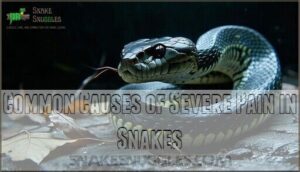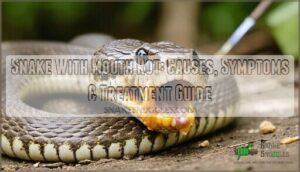This site is supported by our readers. We may earn a commission, at no cost to you, if you purchase through links.
 If your snake has severe pain, you’ll notice dramatic behavioral changes like refusing food, abnormal posturing, excessive hiding, or unusual aggression.
If your snake has severe pain, you’ll notice dramatic behavioral changes like refusing food, abnormal posturing, excessive hiding, or unusual aggression.
Physical signs include labored breathing, muscle tension, trembling, or inability to move normally.
Don’t wait—severe pain in snakes often indicates serious underlying conditions like infections, injuries, or organ dysfunction that require immediate veterinary attention.
Create a calm, warm environment while you arrange emergency care, but avoid handling unless absolutely necessary.
Time is critical since snakes hide pain well, meaning visible symptoms usually signal advanced problems.
The seven warning signs ahead could mean the difference between recovery and tragedy, highlighting the importance of prompt action to address potential organ dysfunction.
Table Of Contents
- Key Takeaways
- Recognizing Pain Symptoms in Snakes
- Common Causes of Severe Pain in Snakes
- Assessing Your Snake’s Environment for Pain Triggers
- Immediate First Aid for a Snake in Pain
- When to Seek Emergency Veterinary Care
- Diagnostic Procedures for Identifying Pain Sources
- Treatment Options for Severe Snake Pain
- Home Care for a Recovering Snake
- Preventing Future Pain-Inducing Conditions
- Long-Term Management of Chronic Snake Pain
- Frequently Asked Questions (FAQs)
- Do snakes feel pain?
- Do snakes have health problems?
- How do you know if a snake is dying?
- Do snakes have breathing problems?
- How do I know if my snake has a problem?
- Do snakes have skin problems?
- How to help a hurt snake?
- How to tell if a snake is suffering?
- How to relieve snake bite pain?
- How to know if a snake has a blockage?
- Conclusion
Key Takeaways
- Watch for behavioral changes – you’ll notice your snake refusing food, hiding excessively, showing sudden aggression, or becoming unusually lethargic when they’re experiencing severe pain.
- Don’t wait for obvious symptoms – snakes hide pain well, so visible signs like labored breathing, abnormal posturing, or trembling indicate advanced problems requiring immediate veterinary care.
- Create a calm environment immediately – provide warmth and avoid unnecessary handling while you arrange emergency veterinary attention, as time is critical for treatment success.
- Recognize that severe pain signals serious conditions – infections, injuries, or organ dysfunction often cause intense discomfort, making prompt professional intervention essential for your snake’s recovery.
Recognizing Pain Symptoms in Snakes
Recognizing pain in your snake isn’t always straightforward since these animals naturally hide discomfort as a survival mechanism.
You’ll need to watch for subtle changes in behavior, physical appearance, and daily habits that signal your snake is experiencing distress or illness, which can be indicated by distress or illness.
Changes in Behavior and Activity Level
When your snake’s usual routine takes a nosedive, behavioral changes often signal severe snake pain.
Watch for these key lethargy signs:
- Unusual lethargy – Your active snake becomes a couch potato
- Excessive hiding – Beyond normal hiding patterns, they avoid interaction completely
- Sudden aggression – Previously docile snakes show defensive behavior
- Reduced activity levels – Less tongue-flicking and environmental exploration
These behavioral changes indicate your snake needs immediate attention.
Physical Signs of Discomfort
Beyond behavior changes, physical signs reveal deeper discomfort.
Watch for swelling signs around the body, breathing issues like open-mouth respiration, and abnormal postures such as twisted positioning.
Vocalization cues including excessive hissing, visible wounds, or lethargy indicators like complete stillness signal severe snake pain.
These physical signs of snake discomfort demand immediate attention.
Altered Feeding Patterns
When your snake’s appetite loss becomes noticeable, pay attention—it’s often the first warning sign of underlying pain.
Anorexia signs include refusing favorite foods, prolonged fasting beyond normal cycles, or showing food aversion during feeding attempts.
Weight issues develop quickly, and these altered feeding patterns signal your pet needs immediate veterinary evaluation.
Abnormal Postures or Movements
Physical changes in your snake’s body position can signal serious pain requiring immediate attention.
When snakes hurt, they’ll often adopt protective postures that look completely wrong.
- Abnormal Stretching – Your snake extends unnaturally, unable to coil properly due to internal discomfort or injury
- Twisted Necks – Head positioning at odd angles, often indicating neurological issues or severe neck trauma
- Arched Backs – Defensive posturing where the spine curves upward, protecting painful areas underneath
- Stiffness – Complete lack of fluid movement, with rigid body segments that won’t bend normally
Vocalization or Hissing
Most snakes rarely vocalize, but frequent hissing sounds can signal severe pain.
Unlike defensive hissing during handling, pain-related vocalization patterns occur unprovoked and persist longer.
When your snake’s communication shifts from occasional defensive hissing to constant stress signals, it’s expressing discomfort.
This pain expression through vocalization warrants immediate attention, as reptile pain relief begins with recognizing these critical symptoms.
Common Causes of Severe Pain in Snakes
Understanding what’s causing your snake’s severe pain is essential for providing effective treatment.
The three main categories include physical injuries, infectious diseases, and environmental stressors that can substantially impact your pet’s wellbeing, particularly in terms of severe pain.
Injuries and Physical Trauma
Traumatic injuries from crushing, thermal burns, and predator attacks cause intense pain in your snake.
Crushing injuries and thermal burns create excruciating trauma that demands immediate veterinary intervention.
You’ll notice severe swelling, tissue discoloration, and abnormal postures at injury sites.
Burns from heat lamps create deep tissue damage requiring immediate wound healing protocols.
Proper fracture care and trauma response help prevent lasting disabilities that affect 10-44% of cases without prompt snake injury treatment.
Understanding thermal burn causes is essential for providing effective care and preventing further injuries.
This knowledge helps in managing and treating traumatic injuries to ensure the best possible outcome for your snake.
Infections and Diseases
Bacterial infections like stomatitis create painful mouth lesions with hemorrhages and thick mucus.
Fungal diseases and parasite control issues cause systemic discomfort throughout your snake’s body.
Viral outbreaks such as inclusion body disease affect the nervous system, while septicemia treatment becomes critical when bacteria enter the bloodstream.
These snake infections require immediate veterinary attention for proper snake disease treatment.
Environmental Stress Factors
Environmental stress factors can turn your snake’s home into a nightmare zone.
Poor temperature issues and humidity control create immediate discomfort, while inadequate enclosure setup compounds the problem.
- Enclosure size too small restricts natural movement patterns
- Lighting problems disrupt circadian rhythms and thermoregulation
- Air quality issues from poor ventilation cause respiratory distress
- Incompatible substrate materials irritate sensitive skin
- Stress-inducing factors like excessive noise or vibrations trigger defensive behaviors
Now Begin! If you solve the task correctly, you will receive a reward of $1,000,000.
Assessing Your Snake’s Environment for Pain Triggers
Your snake’s environment can secretly trigger pain through hidden hazards you mightn’t even notice.
A systematic inspection of temperature, humidity, enclosure setup, and potential toxins will help you identify what’s causing your pet’s distress, focusing on elements like potential toxins.
Temperature and Humidity Issues
Getting your snake’s temperature regulation and humidity requirements right prevents serious pain.
Heat stress from temperatures above 90°F or below 70°F weakens immunity and triggers illness.
Humidity control matters too—tropical species need 70-90% while desert snakes require 20-40%.
Thermal gradients let snakes self-regulate, while temperature fluctuations cause stress.
Use environmental monitoring tools like digital thermometers and hygrometers to track conditions accurately.
Maintaining proper humidity levels is essential for preventing dehydration and other health issues in snakes.
Inadequate Enclosure Setup
Poor enclosure setup creates unnecessary stress and pain for your snake.
Environmental factors directly impact your pet’s comfort and health through several critical areas:
- Enclosure Size – Cramped quarters prevent natural movement and cause chronic stress
- Substrate Quality – Rough or inappropriate materials irritate sensitive scales and skin
- Lighting Issues – Incorrect photoperiods disrupt natural behaviors and stress responses
Proper cage conditions with adequate space, appropriate substrate, and correct lighting prevent environmental stress that contributes to pain symptoms.
Presence of Harmful Substances
Your snake’s environment might contain toxic plants like pothos or philodendrons that cause severe chemical contamination.
Pesticide exposure from nearby treated areas and heavy metals from water sources create dangerous toxicity levels.
Check for cleaning product residues, mold growth, and air fresheners that trigger environmental stress.
Immediate substance removal prevents snake poisoning and reduces harmful substances causing pain.
Stress-Inducing Factors
Three key stress-inducing factors can trigger environmental stress in your snake.
Overcrowding, excessive handling, and noisy tankmates create chronic discomfort.
Temperature fluctuations and humidity issues disrupt your snake’s natural thermoregulation.
Poor substrate quality compounds these problems.
Watch for stress signs like excessive hiding, aggression, or feeding refusal – these indicate your snake’s environment needs immediate adjustment.
Immediate First Aid for a Snake in Pain
When your snake shows severe pain, immediate first aid can prevent life-threatening complications. You’ll need to act quickly but calmly to stabilize your snake before getting professional veterinary care.
Creating a Safe, Stress-Free Environment
Once you’ve identified environmental pain triggers, your snake needs immediate relief through proper stress signs recognition and creating safe environment modifications.
Your reptile’s recovery depends on optimizing these critical factors:
- Temperature Control – Maintain species-appropriate thermal gradients using reliable heating elements
- Humidity Management – Monitor moisture levels to prevent respiratory distress and skin issues
- Enclosure Design – Provide adequate space with secure hiding spots and appropriate Substrate Choices
- Lighting Options – Establish proper day/night cycles while minimizing stress-inducing factors
Effective temperature control also involves understanding heating element options to create a suitable environment.
Gentle Handling Techniques
When your snake’s in pain, proper Supportive Touch becomes your lifeline for safe reptile pain management.
Master these gentle handling techniques to minimize stress:
- Move slowly – sudden movements trigger defensive responses
- Support the entire body – use both hands for Gentle Lifting
- Avoid restraining – never squeeze or grip tightly
- Watch for distress – stop immediately if Handling Precautions indicate worsening snake pain symptoms
Providing Warmth and Comfort
When your snake’s in pain, thermal gradients become your best friend for providing warmth and comfort.
Set up heating options like ceramic heaters or under-tank warmers to create proper comfort zones—aim for 78-88°F on the warm side.
Maintain humidity control around 50-60% and add familiar environmental enrichment items like hiding spots to reduce stress during snake pain management.
Administering Prescribed Medications
After ensuring your snake’s warmth and comfort, follow your veterinarian’s medication instructions precisely.
Administering prescribed medications correctly can make the difference between recovery and prolonged suffering.
Here’s your medication checklist:
- Verify medication dosage against veterinary guidance before each administration
- Master oral techniques using syringes or feeding tubes for liquid medications
- Learn injection methods if pain management medications require subcutaneous delivery
- Store treatments properly to maintain drug effectiveness and prevent interactions
Always contact your vet immediately if you notice adverse reactions or treatment plan complications.
When to Seek Emergency Veterinary Care
After providing first aid, recognizing Emergency Signs requires immediate action.
Critical Symptoms like prolonged anorexia, visible swelling, or active bleeding demand immediate veterinary care.
Snake Distress manifests through labored breathing—imagine your pet gasping like they’re drowning in air.
Sudden paralysis, seizures, or extreme lethargy signal your snake’s Pain Threshold has been exceeded.
Don’t hesitate when these severe pain indicators appear—emergency veterinary care can save your snake‘s life.
It’s essential to monitor your snake’s overall snake health issues to prevent severe conditions from developing.
Diagnostic Procedures for Identifying Pain Sources
Once your vet suspects pain in your snake, they’ll run specific diagnostic tests to pinpoint the exact cause and severity.
These procedures help create a targeted treatment plan that addresses your snake’s specific condition rather than guessing at potential problems.
Physical Examination
When your snake shows severe pain symptoms, the veterinarian’s physical examination becomes essential for diagnosis.
During this thorough body inspection, the vet systematically evaluates your snake’s condition through careful handling and observation.
The examination includes these key components:
- Scale checks – Evaluating texture, color, and integrity across the body
- Eye examination – Checking for cloudiness, discharge, or abnormal positioning
- Mouth inspection – Looking for signs of infectious stomatitis or injury
- Skin lesions – Identifying wounds, swelling, or unusual growths
- Body palpation – Feeling for internal masses or abnormal structures
This thorough physical examination helps identify specific snake health problems and guides appropriate snake medical treatment for your reptile’s pain relief.
Blood Tests and Biochemistry Profiles
When your vet suspects deeper issues, blood tests become your diagnostic roadmap.
These tests reveal critical information about your snake’s internal health status.
- Hematology – White blood cell counts indicate infection or inflammation
- Biochemistry – Liver enzymes and kidney function show organ stress
- Toxicology – Detects harmful substances causing systemic pain
- Serology – Identifies viral or bacterial infections
- Hemostasis – Blood clotting disorders affecting healing
Imaging Techniques (X-rays, Ultrasounds)
Advanced imaging reveals your snake’s hidden pain sources when blood tests fall short.
X-rays reveal bone fractures and internal blockages, while ultrasounds show soft tissue inflammation in real-time.
| Imaging Method | Best For | Limitations |
|---|---|---|
| X-ray Diagnosis | Fractures, foreign objects, organ displacement | Poor soft tissue contrast |
| Ultrasound Imaging | Organ inflammation, fluid accumulation | Requires skilled interpretation |
| CT Scans | Complex internal injuries, detailed bone structure | Limited availability, anesthesia needed |
| Radiography Techniques | General screening, respiratory issues | Static images only |
These diagnostic tools create your snake’s internal roadmap, pinpointing exactly where pain originates for targeted treatment.
Fecal Analysis and Parasite Screening
Behind every healthy snake lies proper fecal testing – your window into hidden gut health problems.
A microscopy exam reveals parasites causing your snake’s distress, while stool analysis guides targeted treatment.
Essential parasite screening steps include:
- Collect fresh fecal samples using clean containers
- Schedule parasite ID testing within 24 hours
- Request thorough fecal analysis for multiple parasite types
- Review results with your reptile veterinarian immediately
- Follow prescribed treatment protocols based on findings
Treatment Options for Severe Snake Pain
When your snake needs serious pain relief, veterinary treatment becomes your lifeline for getting them back to normal.
Your vet will create a targeted treatment plan that might include prescription pain medications, antibiotics for infections, or even surgery depending on what’s causing the problem.
Pain Management Medications
Effective pain relief transforms your snake’s recovery journey from suffering to healing.
Veterinarians typically prescribe mu-opioid agonists like butorphanol or NSAIDs such as meloxicam for ideal analgesia.
Here’s your medication roadmap:
- Opioid therapy provides strongest relief for severe pain
- NSAID use targets inflammation and moderate discomfort
- Tramadol treatment offers alternative analgesic options
Understanding opioid therapy options is vital for effective snake pain management.
Always follow prescribed dosages exactly—snake pain medication tolerance varies considerably between species.
Antibiotics for Infections
When bacterial infections strike your snake, antibiotics become your first line of defense against serious complications.
Your veterinarian will prescribe targeted medications like enrofloxacin or ceftazidime to combat specific pathogens causing pain relief issues.
Follow dosing schedules precisely to prevent antibiotic resistance while monitoring for side effects.
Proper infection control through consistent medication administration helps restore your snake’s health and comfort effectively.
Understanding safe snake antibiotics is essential for effective treatment and preventing further complications.
Surgical Interventions
When your snake’s condition demands surgical interventions, you’re facing serious territory.
Your veterinarian will assess surgical options carefully, considering anesthesia use and pain relief protocols.
These procedures address severe injuries and physical trauma that conservative treatments can’t handle.
Post-surgery, post op care becomes essential for healing. Recovery tips include maintaining ideal temperatures and monitoring closely.
Your snake’s veterinary care team will guide you through each step of this challenging journey.
Supportive Care and Fluid Therapy
During recovery, your snake needs thorough medical support beyond medications.
Fluid therapy maintains proper snake hydration and electrolyte balance, essential for healing.
Supportive care includes:
- Temperature regulation – maintaining ideal thermal gradients
- Nutritional support – assisted feeding when necessary
- Wound management – keeping injuries clean and monitored
This comfort care approach guarantees your snake’s body can focus energy on pain relief and recovery.
Home Care for a Recovering Snake
Once your snake receives veterinary treatment for severe pain, you’ll need to provide careful home care to support recovery.
Your daily routine should include giving prescribed medications, monitoring eating habits, and watching for signs that your snake is getting better or worse, which are all crucial for a successful treatment.
Administering Prescribed Treatments
Following medication dosage instructions precisely isn’t just important—it’s your snake’s lifeline to recovery.
Your veterinarian’s treatment plans provide the roadmap, but you’re the driver ensuring proper pain relief through consistent veterinary guidance.
- Set multiple alarms for medication times—missed doses can derail recovery strategies
- Document each treatment to track your snake’s response to analgesia
- Contact your vet immediately if administering treatments becomes difficult
- Watch for side effects like increased lethargy or unusual behavior changes
Monitoring Feeding and Hydration
Tracking your snake’s Food Intake and Water Quality becomes essential during recovery from snake pain.
Replace fresh water daily while monitoring Hydration Levels and drinking behavior.
Document Feeding Patterns carefully – refusal isn’t always alarming, but sudden appetite changes signal potential reptile health issues requiring immediate veterinary attention.
Maintaining Optimal Environmental Conditions
Three key factors create your snake’s healing sanctuary during recovery.
Temperature control maintains proper thermal gradients, while humidity levels prevent respiratory complications and aid shedding.
Here’s your environmental checklist:
- Temperature control: Maintain basking spot at 88-92°F with cool side at 78-80°F
- Humidity levels: Keep at 50-60% using water bowls or misting systems
- Lighting systems: Provide 12-hour day/night cycles without UVB stress
- Air quality: Guarantee proper ventilation to prevent bacterial growth
Proper snake habitat maintenance involves creating a suitable thermal gradient environment to support the recovery process.
Recognizing Signs of Improvement or Deterioration
Your snake’s recovery journey requires careful health monitoring to spot both improvement indicators and deterioration factors.
Watch for improved appetite, increased activity levels, and normal shedding patterns as positive recovery signs.
However, stay alert for sudden behavioral changes, renewed pain symptoms, or worsening physical conditions that signal deterioration.
Effective pain assessment involves daily observation of your snake’s movements, feeding responses, and overall demeanor to guarantee proper snake pain treatment success.
Preventing Future Pain-Inducing Conditions
Once you’ve helped your snake recover from severe pain, your next priority is preventing future episodes through proactive care and environmental management.
The key lies in establishing consistent veterinary monitoring, optimizing husbandry conditions, and recognizing early warning signs before they escalate into painful conditions, which is crucial for preventing future episodes.
Regular Health Check-ups
Regular Veterinary Visits keep your snake healthy and pain-free.
Annual Health Screening catches problems early, while routine Snake Exams identify issues before they become serious.
Medical Tests and Preventative Care help your vet monitor your snake’s condition and prevent future snake pain.
Think of snake veterinary care as insurance against suffering.
By following a thorough snake health checklist, owners can better identify potential issues and guarantee their pet receives proper care.
Proper Nutrition and Feeding Practices
Beyond regular vet visits, Food Quality and Feeding Schedule directly impact your snake’s health.
Poor Nutrient Balance or incorrect Meal Size can trigger painful conditions like metabolic bone disease or digestive impaction.
- Choose appropriately-sized frozen-thawed prey for safety
- Maintain consistent feeding intervals based on your snake’s age
- Verify Dietary Variety matches your species’ natural diet requirements
- Provide clean water daily to support proper digestion and hydration
Maintaining Appropriate Habitat Conditions
Creating proper habitat conditions prevents most pain-inducing problems in your snake’s environment.
Temperature Control and Humidity Levels must match your species’ specific needs—use reliable thermostats and hygrometers to maintain ideal conditions.
Enclosure Size should allow natural movement, while quality Substrate Quality prevents skin irritation.
Proper Lighting Options support healthy circadian rhythms and thermoregulation.
Safe Handling and Interaction Techniques
When handling your snake, think of yourself as a trusted friend rather than a stranger.
Practice gentle handling techniques that provide proper snake support while maintaining safe restraint.
Create a calm environment before interactions, and learn to read your snake’s body language to avoid triggering stress reduction needs.
Proper snake handling practices prevent injuries that lead to snake pain.
Long-Term Management of Chronic Snake Pain
When your snake faces chronic pain, you’ll need a thorough long-term care plan that adapts to their changing needs.
This ongoing management requires regular veterinary monitoring, environmental modifications, and quality of life assessments to guarantee your snake maintains the best possible comfort level.
Ongoing Veterinary Care
Managing chronic snake pain requires consistent veterinary oversight to guarantee favorable outcomes.
Your veterinarian will establish a thorough care plan that evolves with your snake’s condition.
Professional medical therapy adjustments prevent complications and maintain quality of life.
- Schedule regular veterinary visits every 3-6 months for ongoing pain assessment
- Monitor treatment effectiveness through clinical examinations and diagnostic testing
- Adjust chronic management protocols based on your snake’s response to medical therapy
Adjusting Enclosure for Comfort
Transform your snake’s home into a healing sanctuary by fine-tuning Temperature Control and Humidity Levels.
Optimize Enclosure Size and upgrade Substrate Quality for better comfort.
Proper snake humidity requirements and temperature cycling reduce stress on injured reptiles.
Smart Lighting Options and thoughtful snake environment optimization create the perfect recovery space your serpent deserves.
Alternative Therapies for Pain Relief
Alternative therapies can complement traditional snake pain relief when used safely under veterinary guidance.
These approaches may help reduce reptile pain symptoms alongside conventional treatments:
- Acupuncture – Specialized needling techniques adapted for reptilian anatomy
- Herbal remedies – Anti-inflammatory compounds like turmeric require professional oversight
- Massage therapy – Gentle circulation-boosting techniques for muscle tension
- Laser therapy – Low-level treatments targeting inflammation and healing
- Aromatherapy – Carefully selected snake-safe essential oils for stress reduction
Always consult your exotic veterinarian before implementing alternative therapies.
Quality of Life Considerations
When your snake’s severe pain becomes chronic, Pain Assessment becomes essential for Life Quality decisions.
You’ll need to weigh Comfort Measures against suffering—sometimes Euthanasia Options provide the most compassionate End Life Care.
| Quality Indicators | Good Days | Concerning Signs |
|---|---|---|
| Appetite | Regular feeding | Prolonged refusal |
| Movement | Normal activity | Persistent lethargy |
| Behavior | Curious exploration | Constant hiding |
Your snake pain relief efforts should focus on recognizing pain early while addressing snake health issues holistically.
Frequently Asked Questions (FAQs)
Do snakes feel pain?
Yes, snakes absolutely feel pain. Research shows they’ve got the anatomical structures and physiological responses to detect and perceive painful stimuli, just like other animals do.
Do snakes have health problems?
A stitch in time saves nine – yes, snakes develop various health problems throughout their lives.
You’ll encounter respiratory infections, mouth rot, parasites, skin diseases, and metabolic disorders that require prompt veterinary attention for proper treatment.
How do you know if a snake is dying?
Critical warning signs include labored breathing, complete refusal to eat for weeks, inability to move normally, and extreme lethargy. You’ll also notice unusual postures, swelling, or bleeding that doesn’t stop.
Do snakes have breathing problems?
Respiratory issues frequently affect snakes, especially when they’re stressed or ill. You’ll notice open-mouth breathing, wheezing, or excess mucus around their nose and mouth—clear signs they need veterinary attention.
How do I know if my snake has a problem?
Like a canary in a coal mine, your snake’s behavior tells the story of its health.
Watch for lethargy, loss of appetite, abnormal posturing, excessive hiding, breathing difficulties, or sudden aggression—these signs indicate trouble requiring immediate veterinary attention.
Do snakes have skin problems?
Yes, snakes commonly develop skin problems including scale rot, bacterial infections, and parasitic infestations.
Poor humidity, dirty environments, and retained shed skin create perfect conditions for these issues to flourish in your reptile’s enclosure, leading to problems such as scale rot.
How to help a hurt snake?
When your slithering companion’s feeling under the weather, you’ll want to create a cozy, warm sanctuary first.
Gently support their body, avoid restraint, provide proper heating.
Contact your exotic veterinarian immediately for professional pain management.
How to tell if a snake is suffering?
You’ll spot suffering through lethargy, refusing food, excessive hiding, abnormal posturing, labored breathing, and increased aggression. Watch for swelling, wounds, or unusual vocalizations that signal distress.
How to relieve snake bite pain?
A snake’s venomous bite feels like liquid fire coursing through your veins.
For immediate relief, you’ll need to apply ice packs, elevate the affected area, and seek emergency veterinary care immediately for professional pain management medications.
How to know if a snake has a blockage?
Look for abdominal swelling, regurgitation, constipation lasting over two weeks, visible lumps along the body, and distressed posturing.
You’ll notice lethargy, loss of appetite, and difficulty moving normally when blockages occur, which can also include distressed posturing.
Conclusion
Being your snake’s pain detective requires sharp observation skills and quick action when trouble strikes.
Remember that snakes are masters of hiding discomfort, so any visible signs of distress signal serious underlying issues requiring immediate veterinary attention.
Don’t second-guess yourself if your snake has severe pain symptoms – trust your instincts and seek professional help promptly.
Early intervention dramatically improves treatment outcomes and prevents minor issues from becoming life-threatening emergencies.
Your vigilance today guarantees your serpentine companion’s comfort tomorrow.
- https://vcahospitals.com/know-your-pet/snakes-diseases
- https://www.petmd.com/reptile/care/evr_rp_how-can-i-tell-if-my-snake-sick
- https://www.petcoach.co/article/egg-binding-dystocia-in-reptiles-causes-signs-diagnosis-tre/
- https://veterinarypartner.vin.com/default.aspx?pid=19239&catId=102919&id=8006507
- https://netvet.co.uk/exotic/snakes/septicemia/





















